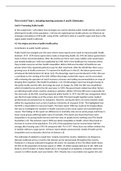This is Unit 8 Task 1, including learning outcome A and B. Distinction
Unit 8- Promoting Public health
In this assignment, I will explain how strategies are used to develop public health policies and factors
affecting the health of the population. I will also be explaining how health policies are influences by
strategies and patterns of ill health. Using all this I will link to data in a specific region and how in this
region public health is affected.
A1- the origins and aims of public health policy
Contributors to public health systems
Public health has changed over the years where many reports were made to improve public health.
between 1919- 1939 many reports were made on improving health. By 1945 the labour government
took on these recommendations. After the worlds war there were many soldiers who would injure
and needed healthcare, NHS was established by 1948. NHS is free healthcare for everyone where
they include everyone and less health inequalities. Before NHS was founded, all healthcare was
private where they expected patients to pay for their treatment. After the World War there was a
growing issue of health provisions. To improve the healthcare in the UK, the labour government
introduced the NHS (Historic UK, Brain, N.d). The Beveridge report was introduced in 1942, this was
a contribute to the starting of the NHS. William Beveridge created this report, and he was tasked
with reviewing the operation of social insurance schemes and making recommendations on ways of
bringing them together (The Health Foundation, n.d). The Beveridge report has brought change to
the public health and the NHS, this brings the start of change. By 1948, the NHS was established
which is funded by tax and is free for everyone. In 1970, the government realise how other factors
are affecting health which could be smoking or pollution. Within 1974 the NHS were responsible for
the most parts of the NHS, ensuring improved public health. In 1974, the NHS was reorganised which
was the first major shake up of the service since 1948. This has brought together senior medical
professionals are planned how to reorganise. However, during this there are many mistakes made
within the organisation such as lack of policies (University of Liverpool 2016). This highlighted how
the NHS is responsible for everyone health. The black report 1980 was made by Sir Douglas Black,
this was to investigate the variation in health outcomes across social classes and considering the
causes. The findings of the report are differences in mortality rates across social groups and those in
lower social groups suffering higher rates of mortality. This report also found that there were
inequalities in accessing health services with low rates of uptake by the working class (The health
foundation n.d). The Acheson report 1998 was about inequalities in health, where they found an
increase in income of the population. The 24% of the population had an income below half the
average after housing costs 1995-96 compared with 7% in 1977. More than one million children live
in families without a wage earner. Acheson report adopts socioeconomic model of health and its
inequalities such as education (Archives of disease n.d).
The outbreaks of epidemics caused fear/ anxiety around the country. Epidemics are dangerous
diseases outbreak across a country, this disease can be spread easily throughout the country.
Pandemic is a disease outbreak throughout the world. An example of this I the Black death where
30-50% of the population of Europe wiped. In 1980s, 35 million people died due to HIV, AIDS and
Ebola in 2014 (Frontiers in Public Health 2021). An example of an epidemic is measles where this
caused 2.6 million deaths each year before 1963. Measles has a vaccination now against this and
, prevent the outbreak again. More than 140,000people died from measles in 2018 which is a
decrease from 1963. Global measles deaths have decreased by 73% from 2000 to 2018 (WHO 2019).
Aims of public health policy
Planning and promoting health
Department of health and social care, public health England, NHS will work together to promote and
improve the health of the population. The DH and the NHS will do research to see different area of
the UK national health. Each area could have different health such as London having higher rates of
high blood pressure. The DH and the NHS is responsible of promoting the health of the population
and planning of provision o0f healthcare. The NHS has promoting health by making schemes to help
health such as eat well plate; this helps all individuals eat well and healthy if followed correctly.
Another way the NHS has planned and promote health by the NHS Long Term, this focuses on
treatment and prevention of illness. This plan works with the government, public health England and
local government to prevent disease or injury before it occurs. Secondary prevention help support
changes in behaviours or lifestyles factors that improve a health of an individual. They cover factors
such as smoking, alcohol, obesity and antimicrobial resistance. This was planned by the NHS to
improve the health of the population by preventing ill health before it occurs (NHS, n.d). To meet the
needs of the UK we need to plan to prevent disease or ill health for the future. Another example of
planning is swine flu epidemic in 2009, where the government needed to plan to prevent this
disease and how to stop the spread. Swine flu mostly affected age groups of 5-14 years old and the
cases peaked up to 110,000.
This graph shows the swine flu cases between June
to December. It has peaked the highest during end of
July with around 150,000 cases and slowing decrease
to 80,000 cases in September (Wikipedia n.d). for the
government to meet the needs of the population
they would have researched in data and do reports
and make changes to health. Factors such as
unemployment, education or housing will have an
impact on the planning for health provision. As the
population is increasing the government would need
to keep up with these health needs and plan.
Identifying and monitoring needs
It is important to understand the needs of the population as this will improve the health. A needs
assessment would be done to understand the needs and types of distribution of health and social
care. An example of a need assessment is Joint Strategic Needs assessment which could be done to
support the development of planning. This will look at the needs of the population and what are the
inequalities. It is important to monitor the population health as if there are inequalities, the NHS or
DH can plan to improve this. We carry out this assessment by identifying what’s the issue is and
where it is affecting (Public health 2021). When researching about the needs of a population, we
may come across inequalities in health. Since WW2 the government has identified issues such as
poverty where the government is a provider for the population welfare. An example of how the
government identified was in 1970s and 1980s public information films were shown these show
issues such as handling of fireworks and sexual health (Health and social care textbook, n.d). The





